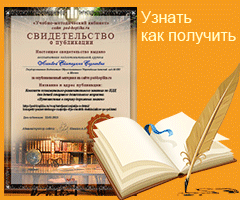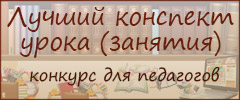Урок английского языка на тему "Покупки", 8 класса. Конспект с презентацией
Конспект урока по английскому языку для 8 класса на тему "Продукты питания и покупки"
Тема: “Продукты питания и покупки” (8 класс)Цель: закрепление употребления лексических единиц в речи.
Задачи: закрепить лексический и грамматический материал, научить составлять диалоги о покупках, развивать навыки чтения, аудирования, письменной и устной речи, развивать память, мышление, внимание, интерес к изучению английского языка, воспитывать культуру поведения.
Тип урока: урок закрепления материала
Оборудование: презентация, карточки, учебник для общеобразоват. организаций.(Английский в фокусе. 8 класс)/Ю. Е. Ваулина, Д. Дули, О. Е. Подоляко и др. – М.: Просвещение, 2016.
Ход урока
1.Организационная часть урока. Сообщение темы урока. Постановка цели и задач.
2. Фонетическая зарядка
Учащиеся читают стихотворение о покупках, закрепляют употребление лексических единиц в речи. Учитель обращает внимание на произношение учащихся.
T: Today we are going to talk about different kinds of shops, food and shopping.To prepare us for speaking let’s revise our English poem “Shopping”
Shopping, shopping,
Let’s go shopping,
We can buy a lot of food.
Bread and butter,
cheese and sausages,
Vegetables and fruit.
Shopping,shopping,
Let’s go shopping,
We can buy a lot of food,
Bread and butter, cheese and ice-cream,
It is so good!
3. Речевая зарядка
Учитель просит учащихся составить ассоциативные ряды со словом “магазины". Учащиеся называют разные виды магазинов, перечисляют продукты питания, которые можно в них купить. Во время проведения интерактивного упражнения учащиеся составляют предложения с ранее изученными лексическими единицами.
T: What associations have you got with the word “shops”? Look at the spidergram, recollect the lexical units. What kinds of shops do you know?
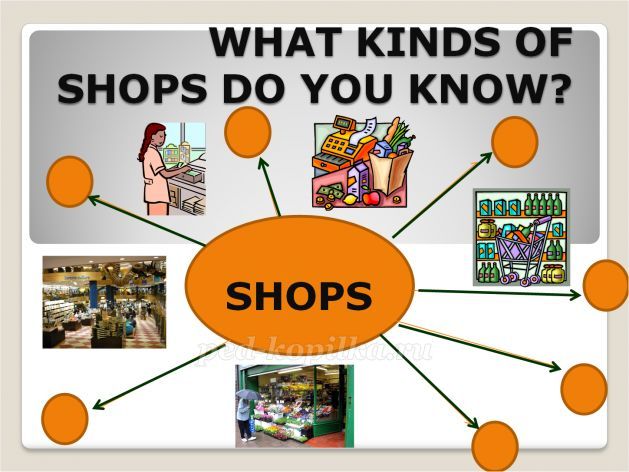
P1: a toy store, a clothes shop, a bookshop, a chemist’s, a furniture shop, a bakery.
P2: a department store, a jeweller’s, a florist’s, an optician’s.
T: Look at the slides. What kinds of shops are these?
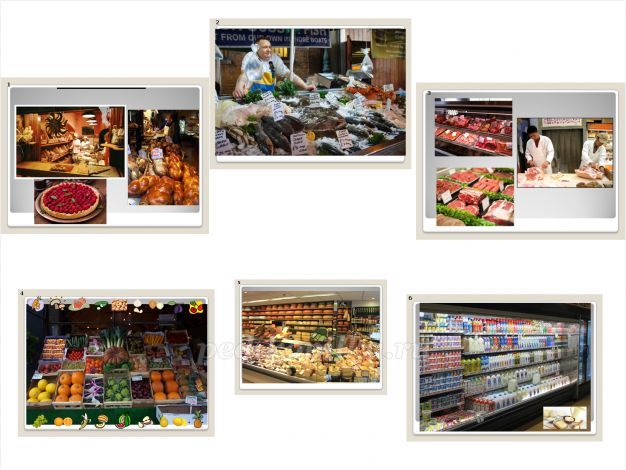
P1: It’s a bakery
T: What can we buy at the bakery?
P1: We can buy cakes, rolls, biscuits and a loaf of bread.
P2: It’s a fishmonger’s.
T: What can we buy at the fishmonger’s?
P1: We can buy prawns, different kinds of fish at the fishmonger’s.
T: What can you say about the next shop?
P3: It’s a butcher’s.
T: What can we buy at the butcher’s?
P3: We can buy sausages, poultry, caviar and all kinds of meat.
T: Look at the next slide. What shop is it?
P4: It’s a greengrocer’s.
T: What can you buy at the greengrocer’s?
P4: We can buy fruit and vegetables, for example, apples, oranges, tomatoes, potatoes, cucumbers.
P5: It’s a dairy. We can buy butter, cheese, sour cream and milk here.
P6: It’s a chemist’s. We can buy medicine, drops or painkillers at the chemist’s.
4. Актуализация знаний
Проверка домашнего задания
Во время выполнения лексического упражнения учащиеся должны были правильно выбрать слово и
закончить предложения по теме "Покупки". Учащиеся читают свои предложения и объясняют ответ.
Vocabulary
T: Your homework was to review the words. Read and finish the sentences.
1. Those people who buy things are___. (customers)
2. The salesgirl stands behind the __ . (counter)
3. The customers pay money to the _____. (cashier)
4. In some shops there are no salesmen or salesgirls, but only cashiers.
They are called ___________. (selfservice shops).
5.The customers give the bill and money to the cashier, who gives us a ____ and our ______. (check, change).
6. You can buy medicine, drops or painkillers at the _____. (chemist’s).
7. Some shops have many departments. They are called _________. We can buy____ here. (department stores, everything).
8. You can buy newspapers and magazines at the ______. (newsagent’s)
9. We usually buy roses, tulips, daisies at the ______. (florist’s)
10. The pink dress costs 75 pounds. Today it’s 50 pounds with the __. (discount)
11. You can check your eyesight and buy spectacles or sunglasses at the _____. (optician’s)
5. Закрепление материала
Аудирование
Во время проведения аудирования учащиеся слушают диалог о покупках. После прослушивания текста они заполняют таблицы в карточках, отвечают на вопросы, поставленные учителем.
T: Listen to the dialogue at the market and answer the following questions.
1. What fruit is the customer buying at the market?
2. What fruit cannot she buy?
3. How many kilos of strawberries is the customer buying?
4. What vegetables is she buying?
5. How much do they cost?
Dialogue
- Fresh fruit, vegetables…
- Good morning!
- Good morning! Can I help you?
- Can I have three oranges, please.
- Anything else?
- Have you got grapes?
- Sorry, we haven’t any grapes today. What about strawberries? They are very cheap.
- How much are they?
- 5.50 a kilo.
- OK. Half a kilo then… and half a kilo of carrots.
- Anything else? What about nice tomatoes?
- No, thank you. How much is that?
- 2. 75 for strawberries.
One pound for the carrots.
1.20 for the oranges.
That’s 5. 95
- 5.95? That’s 4.95
- Sorry. 4.95. Here you are. It’s your change.
- Good-bye!
- Good-bye!
T: Fill in the table correctly.

Key:
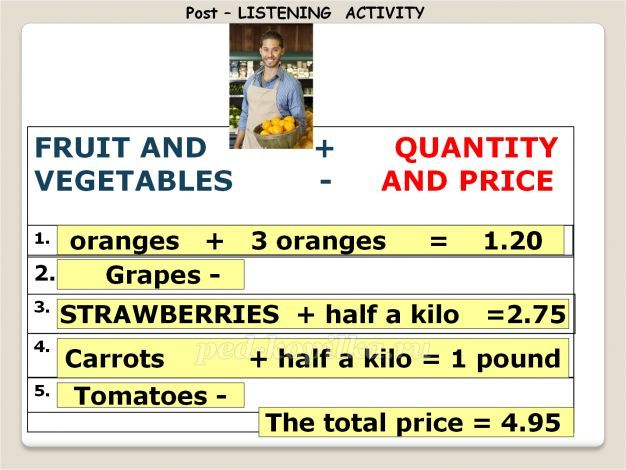
Speaking
Составление диалогов
Учащиеся выбирают роль продавца или покупателя, составляют свои диалоги по образцу. Учитель анализирует ошибки учащихся после проведения ролевой игры.
T: Make up your dialogues. Imagine that you are at the supermarket. Choose the role of a seller or a customer. Look at the slide. You can use the following phrases.
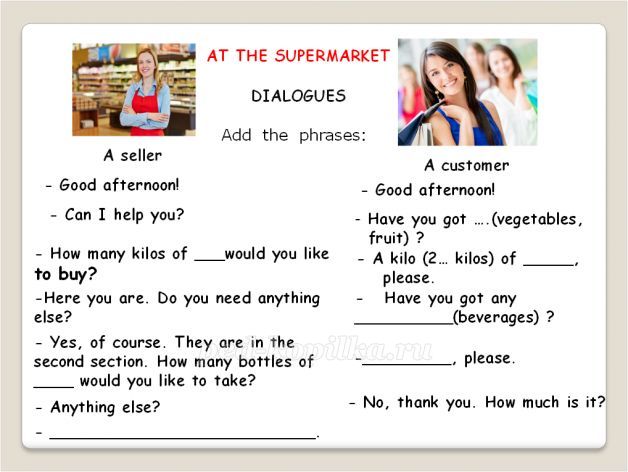
P1: Good afternoon!
P2: Good afternoon!
P1: Can I help you?
P2: Have you got apples and plums?
P1: Yes, I have. How many kilos of fruit would you like to buy?
P2: A kilo of apples and half a kilo of plums.
P1: Here you are. Do you need anything else?
P2: Have you got any beverages?
P1: Yes, of course. They are in the fifth section. What beverages would you like to buy?
P2: Two bottles of milk and a carton of orange juice, please.
P1: Here you are. Anything else?
P2: No, thank you. How much is it?
P1: 12.45, please.
P2: Thank you. Good-bye!
P1: Good-bye!
Song
T: Let’s listen and sing the song “At the market”
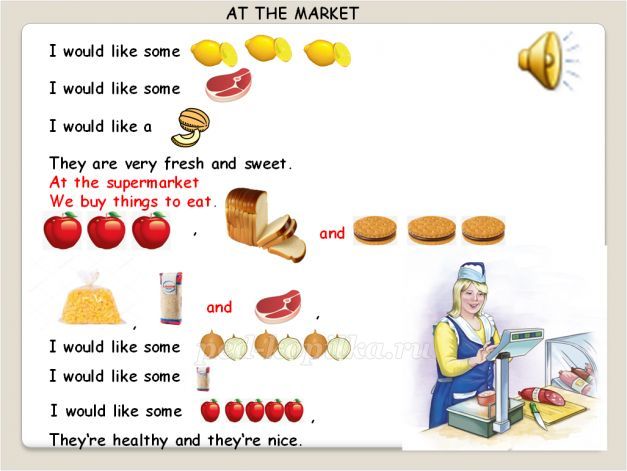
Работа по учебнику.
Учащиеся выполняют лексические и грамматические упражнения по учебнику (стр.40 упр.1,3). Если ученик допускает ошибку в использовании временного глагола, то учитель не перебивает выступление ученика, а по окончании устного ответа с помощью схемы времён объясняет использование данного временного глагола. Данная стратегия эффективна, поскольку не только выступающий ученик, но и все участники имеют возможность повторить грамматическую структуру.
Lexical practice
T: Read the sentences and use the correct words.
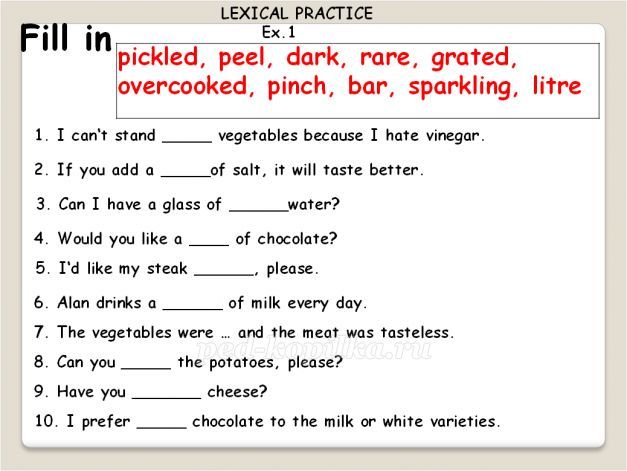
Key: 1. pickled, 2. pinch, 3. sparkling, 4. bar, 5. rare, 6. litre, 7. overcooked, 8. peel, 9. grated, 10. dark
Grammar practice
T: Complete the sentences with the Present Perfect or Present Perfect Continuous forms of the verbs in brackets.
1. Jane ____(go) to the market. She‘ll be back in forty minutes.
2. She _____(not\buy) a chocolate cake yet.
3. How long ___ (John\save) to buy a new car?
4. Steve and Sam (do) shopping for 2 hours.
5. ____( he\ever\eat) Thai food?
6. Ann ____just (design) this new dress.
7. They ______(already \pay) in cash.
Key: 1. has gone, 2. hasn’t bought, 3. has John been saving, 4. have been doing, 5. Has he ever eaten, 6. has just designed 7. have already paid.
6. Подведение итогов урока
Учитель оценивает деятельность учащихся на уроке.
7. Домашнее задание ex.3 p.40
Учитель объясняет, как выполнять задания в рабочей тетради.
T: Complete the sentences with the Present Perfect or Present Perfect Continuous forms of the verbs in brackets, repeat dialogues about shopping.
СПИСОК ИСПОЛЬЗОВАННОЙ ЛИТЕРАТУРЫ
1. Баграмова Н.В. Интерактивный подход в обучении иностранным языкам: Санкт-Петербург, 1996. – 177с.
2. Белова Л. В., Рахманкулова Л. К. Некоторые приёмы работы с картинками на уроках английского языка // Иностранные языки в школе.- 1991.- № 2.-с.72-75.
3. Галльская Н.Д. Современная методика обучения иностранным языкам/ Н.Д. Галльская - М.: АРКТИ, 2003. - 129 с.
4. Корнеева Л.И. Современные интерактивные методы обучения: зарубежный опыт// Университетское управление.-2004.-№4.- С. 78-83.
5. Полат Е.С., М.Ю. Бухаркина, М.В.Моисеева, А.Е. Петрова “Новые педагогические и информационные технологии в системе образования”- М., 2004.
Презентация на тему: Продукты питания и покупки
Рекомендуем посмотреть:
 Конспект урока английского языка для 8 класса с презентацией. Англоговорящие страны
Конспект урока английского языка для 8 класса с презентацией. Англоговорящие страны
 Интерактивная игра по английскому языку, 8 класс
Интерактивная игра по английскому языку, 8 класс
 Открытый урок по английскому языку, 8 класс. Тема: Хобби. Конспект с презентацией
Открытый урок по английскому языку, 8 класс. Тема: Хобби. Конспект с презентацией
Участник №4 профессионального конкурса для педагогов «Лучший конспект урока (занятия)» с 1 ноября 2021 года по 30 января 2022 года
|
|
Автор: Марина Сергеевна Долгих
Опубликовано: 1097 дней назад (21 декабря 2021)
Просмотров: 10114
Рубрика: Без рубрики
|
+1↑ Голосов: 1 |
| # 24 декабря 2021 в 21:17 0 |
| # 17 декабря 2024 в 22:22 0 |
